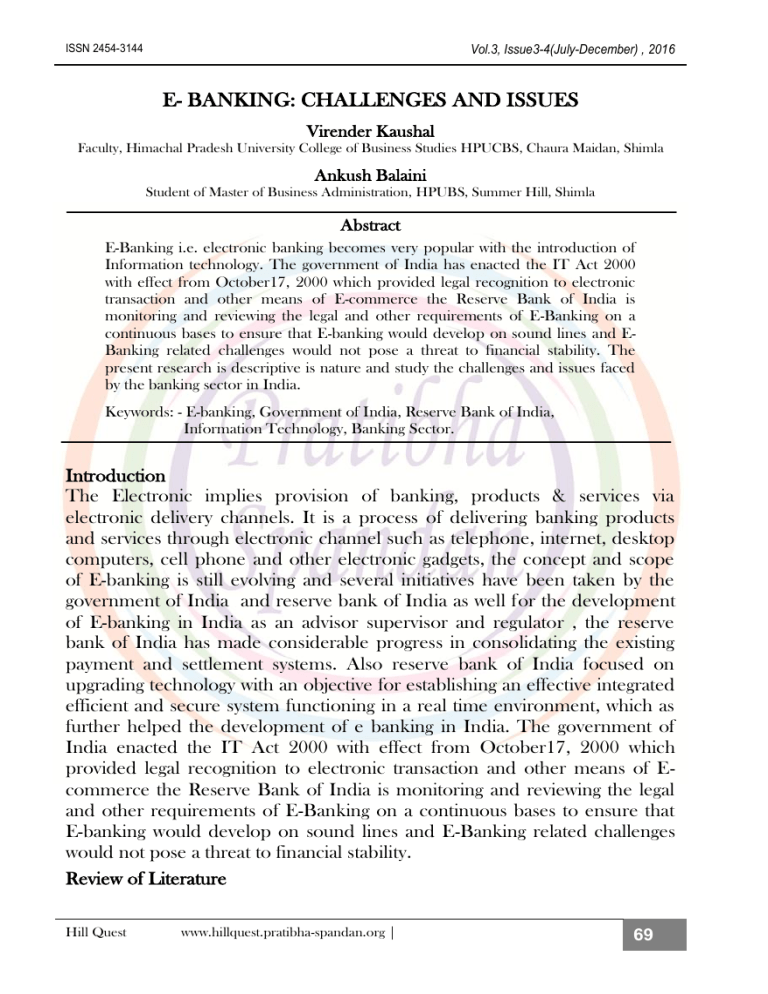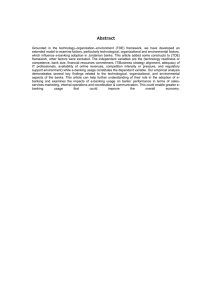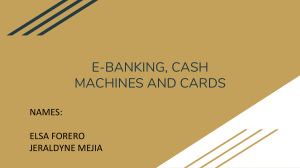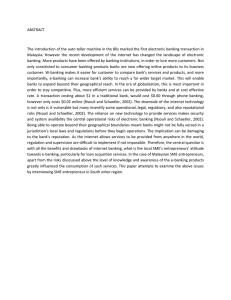
ISSN 2454-3144 Vol.3, Issue3-4(July-December) , 2016 E- BANKING: CHALLENGES AND ISSUES Virender Kaushal Faculty, Himachal Pradesh University College of Business Studies HPUCBS, Chaura Maidan, Shimla Ankush Balaini Student of Master of Business Administration, HPUBS, Summer Hill, Shimla Abstract E-Banking i.e. electronic banking becomes very popular with the introduction of Information technology. The government of India has enacted the IT Act 2000 with effect from October17, 2000 which provided legal recognition to electronic transaction and other means of E-commerce the Reserve Bank of India is monitoring and reviewing the legal and other requirements of E-Banking on a continuous bases to ensure that E-banking would develop on sound lines and EBanking related challenges would not pose a threat to financial stability. The present research is descriptive is nature and study the challenges and issues faced by the banking sector in India. Keywords: - E-banking, Government of India, Reserve Bank of India, Information Technology, Banking Sector. Introduction The Electronic implies provision of banking, products & services via electronic delivery channels. It is a process of delivering banking products and services through electronic channel such as telephone, internet, desktop computers, cell phone and other electronic gadgets, the concept and scope of E-banking is still evolving and several initiatives have been taken by the government of India and reserve bank of India as well for the development of E-banking in India as an advisor supervisor and regulator , the reserve bank of India has made considerable progress in consolidating the existing payment and settlement systems. Also reserve bank of India focused on upgrading technology with an objective for establishing an effective integrated efficient and secure system functioning in a real time environment, which as further helped the development of e banking in India. The government of India enacted the IT Act 2000 with effect from October17, 2000 which provided legal recognition to electronic transaction and other means of Ecommerce the Reserve Bank of India is monitoring and reviewing the legal and other requirements of E-Banking on a continuous bases to ensure that E-banking would develop on sound lines and E-Banking related challenges would not pose a threat to financial stability. Review of Literature Hill Quest www.hillquest.pratibha-spandan.org | 69 ISSN 2454-3144 Vol.3, Issue3-4(July-December) , 2016 Karimzadeh and Alam indicated in their study that legal and security, sociocultural and management and banking issues are expected as challenges for the development of E-banking but that there is less awareness regarding new technologies and unsuitable software which are ranked respectively as the highest and lowest obstacles in India. Aladwani conducted research about the drivers and challenges of online banking; the results of the study show that to bank managers are in support of a lack of internet specialists and changes in Internal technology being the principle issues relevant to online banking development whereas IT managers mentioned time and budget constraints and also immature Internet Technology. The study also indicates that according to general and IT managers‟ technical obstacles are the most important challenge for the development of E-banking. Customers however mentioned internet security, online banking regulations and customers‟ privacy as the most important future challenges of E-banking in Kuwait. Vaithianathan in his study commented that due to the high Internet penetration among developed countries‟ populations, these countries are able to deploy electronic commerce to their advantages, whereas developing countries are still trailing far behind. Apart from this other issues such as lack of technology infrastructure, lack of awareness, lack of skilled human resources and social factors are cited as hurdles that prevent pervasive Ecommerce adoption in developing countries. Objectives of the Study To study the concept of E-banking in India. To understand the latest trends in the banking sector. To highlight the challenges faced by E-banking systems. Research Methodology The present studies based on secondary data and is descriptive in nature. The secondary data has been collected through various resources such as books, research journals, articles, reports of Reserve Bank of India and planning commission of India (NITI Ayog). Products and Service Offered To cope with the pressure of growing competition Indian commercial banks have adopted several initiatives and E-banking is one of them. The competition has been especially tough for the public sector banks as the newly formed foreign banks and private sector banks are leaders in the 70 | Hill Quest www.hillquest.pratibha-spandan.org ISSN 2454-3144 Vol.3, Issue3-4(July-December) , 2016 adoption of E-banking. The Indian banks offered following E-banking products and services to their customers: Automated Teller Machines [ATMs] Internet Banking (onlinesbi.com) Mobile Banking ( Bank apps ) Tele Banking ( NUUP) Electronic Clearing Services Electronic Clearing Cards Smart Cards Doorstep Banking Electronic Fund transfer Challenges and Issues in E-Banking Security Risk- It is very big challenge for E-banking, very big challenge to make consumers and marketers to opt it because of security issues. We have heard of various internet frauds, fishing acts, password hacks etc. According to the IAMAI report (2006), 43% of internet users are not using internet banking in India because of security concerns. So, it‟s a big challenge for increase in online banking use. Privacy Risk- Peoples fear very much from the fact that there is fear of identity theft and disclosing private information in online or E-banking (wiki leaks, panama paper leaks etc.). They feel bank may invade their privacy by utilizing their information for marketing and other secondary purposes without consent of consumers. People feel very much irritated when they receive calls for credit cards or insurance etc. Trust Factor- Trust is the biggest thing when you have to do anything, especially when you do a financial transaction you have to have full faith on the medium you are using, the site you are using the connection etc. There arise several questions in mind of users: Did transaction go through? Did I push the transfer button once or twice? Is my Password and ID is secured? Trust is very important factor which influence the customers‟. Customer Awareness- Villages are backbone of India and when we talk about villages, peoples are still not aware of banks, so in India there is a long way for E-banking. So we first have to educate peoples first about the banks system and then slowly have to educate them. Holes- Any defect in hardware, software or privacy policy, use of-banking in open networks or unsecure networks allows hackers to have unauthorized Hill Quest www.hillquest.pratibha-spandan.org | 71 ISSN 2454-3144 Vol.3, Issue3-4(July-December) , 2016 access. The network tolls that can be affected by holes are routers, server software, operating system, firewalls and clients. Money Laundering Risk- Since internet banking can be done remotely, banks may find it difficult to apply traditional methods for preventing and detecting undesirable criminal activities like money laundering. Applications of money laundering rules may not be adequate for some forms of Epayments. Cyber Squatting- It is the act of registering a famous domain name and then selling it for a fortune. Cyber squatters register providers‟ domains so as to attract their users and benefit from it. This is an issue that has not been covered in the IT Act, 2000. Languages And Literacy Barriers- Unfamiliar language and illiteracy are barriers in using E-banking service are mostly in English language. It is very difficult in country like India with 1.252 Billion populations only about 79% of literate peoples & most of them in regional language it is also very big barrier. Fraud By Human Resource Of The Bank- When you have the access to a plenty of information and the information is in hands of a person we can trust anyone. There are several peoples who use their own gain and may cause loss to both customer as well as bank. Remedies To Cope With Challenges Spreading Awareness- In a country like India where most of the peoples are not so literate and even they don‟t have any bank account. We must spread awareness in peoples about banks and E-banking facilities, their benefits and easy to use facilities. Improving Security- When we move to something new and when it is related to money there are various security risk, banks and government have to made their system powerful and secure so that can‟t be hacked by anybody. Training And Development For Employees- When there is a sudden change in technique or technology or system, some peoples have the barriers of adopting it even bank employees, so banks must train their employees for new technology and new process so that they can understand and tell other peoples about it. Simplicity Is Best- When we have to make people use E-banking it should be quick, simple and useful so that people should be use to it and feel confident when using it. 72 | Hill Quest www.hillquest.pratibha-spandan.org ISSN 2454-3144 Vol.3, Issue3-4(July-December) , 2016 Conclusion Online, internet, virtual, phone banking and ATMs are the products or services or application of E-banking. It is considered as a remarkable development in the banking sector. E-banking helps banks and government to keep a record of transactions, helps banks to reduce their paperwork, it is very less time consuming and accurate. It helps customers to not to wait in queues for transactions, make it easy for them to keep records of their transactions and spending. So, E-banking is the future of banking and we as peoples, banks and government have to apply it with grace, we must welcome it with open mind. References Aladwani, A, M. (2001),”Online banking: A field study of drivers, development challenge and expectations”. International Journal of Information Management, 21 (2001) : PP(213-225) Chalan, G.V. and Nageswara, K.S (2006).”E-Banking application in Indian Banks: Emerging Issues”. Professional Banker, Vol. 17,(2),:PP(72-82) Chauhan Vikas and Choudhary Vipin (2015).”Internet Banking: Challenges and opportunities in Indian context”. Apeejay-Journal of Management Sciences and Technology. Vol.2, Issue-3, June-215, PP(29-40). Frauds in the banking sector: Causes, concerns and cures”. http://rbidocs.rbi.org.in/rdocs/speeches/PDFs/DGKCAF290713.pdf Growth and extent of electronic banking services in India”. http://shodhganga.inflibnet.ac.in/bitstream/10603/3563/12/12_chaptter%204.p df Khalfan, A. and Alshawaf,A. (2004). “Adoption and Implementation problems of Ebanking: A study of the Managerial perspective of the banking Industry in Oman”. Journal of global information technology management,7,(1), PP(4764). Lal Roshan and Saluja Rajni (2012) “ E-banking: The Indian Scenario”. Asia pacific journal of marketing and management riview, Vol-1,issue 4, Dec 2012, PP (1625). ISSN:2319-2836. Availble online at http://www.indianresearchjournals.com Pooja (2015) “ E-banking: A pioneering Service approach in comercial banks in India”. Pacific business riview international VOL.8, issue IV, Oct2015, PP(5865). Singh Preeti (2013) “ An exploratory study on Internet Banking usage in SemiUrban Areasin Inida”. International Journal of scientific and research publications, Vol-3, Issue8, Aug 2013, PP(1-5). ISSN:2250-3153. Verma Amit “E-banking management in India”. Tactfull mangement research journal, PP(1-4). ISSN:2319-7943 Hill Quest www.hillquest.pratibha-spandan.org | 73



